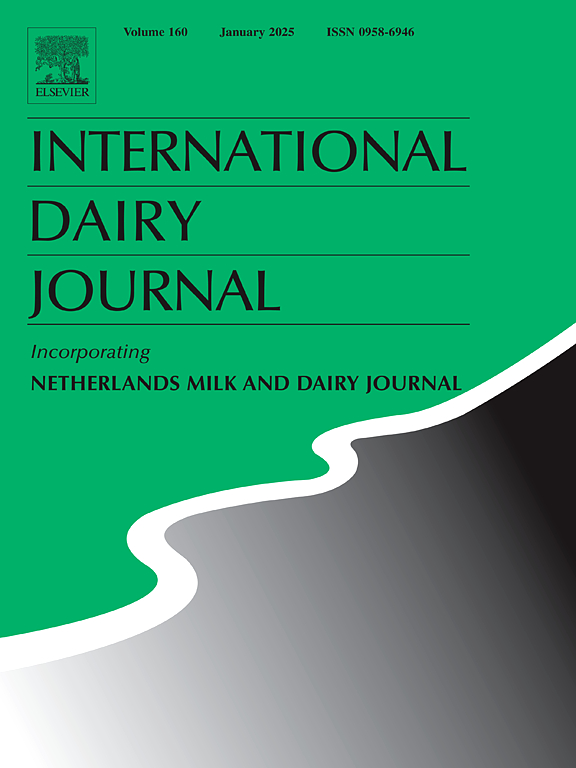城市化和季节性对印度大城市班加罗尔奶牛日粮和牛奶脂肪酸分布的影响
IF 3.4
3区 农林科学
Q2 FOOD SCIENCE & TECHNOLOGY
引用次数: 0
摘要
为了探讨城市化对牛奶脂肪酸(FA)分布的影响,研究人员在三个季节访问了印度南部班加罗尔城市和城郊地区的39名农民。在2021年冬季(n = 74)、2021年季风季节(n = 61)和2022年夏季(n = 104)收集了奶牛的品种、产奶量和品质以及日粮组成数据。城市和季节的位置影响产奶量,城市和冬季的产奶量最高。牛奶脂肪含量和FA分布也因地点和季节而异,城市奶牛的牛奶含有更多的亚油酸(36%)、n-3(40%)、n-6(35%)和不饱和FA(11%),而非城市奶牛的牛奶含有更多的亚油酸(36%)、n-3(40%)和不饱和FA(11%)。冬季牛奶的亚油酸(19%)和n-6 (17%) FA含量最高,而夏季牛奶的油酸(7%)和不饱和脂肪酸(5%)含量较高。结果表明,土地有限的农民使用的替代饲料能够为消费者提供高质量的产品。本文章由计算机程序翻译,如有差异,请以英文原文为准。
Urbanization and seasonal effects on dairy cow diets and milk fatty acid profiles in the Indian Megacity of Bengaluru
To explore urbanization effects on milk fatty acid (FA) profile, 39 farmers from urban and peri-urban locations in Bengaluru, southern India, were visited during three seasons. Individual cow data was collected on breed, milk yield and quality, as well as diet composition in winter 2021 (n = 74), monsoon 2021 (n = 61), and summer season 2022 (n = 104). Location within the city and season affected milk yield, with highest values recorded for urban locations and winter. Milk fat content and FA profiles also varied between locations and seasons, with milk from urban cows containing more linoleic (36 %), n-3 (40 %), n-6 (35 %), and unsaturated (11 %) FA than milk from peri-urban cows. Winter season milk had the highest concentrations of linoleic (19 %) and n-6 (17 %) FA, whereas summer season milk contained more oleic (7 %) and unsaturated (5 %) FA. The results suggest that the alternative feedstuffs used by land-constrained farmers are capable of yielding a high-quality product for consumers.
求助全文
通过发布文献求助,成功后即可免费获取论文全文。
去求助
来源期刊

International Dairy Journal
工程技术-食品科技
CiteScore
6.50
自引率
9.70%
发文量
200
审稿时长
49 days
期刊介绍:
The International Dairy Journal publishes significant advancements in dairy science and technology in the form of research articles and critical reviews that are of relevance to the broader international dairy community. Within this scope, research on the science and technology of milk and dairy products and the nutritional and health aspects of dairy foods are included; the journal pays particular attention to applied research and its interface with the dairy industry.
The journal''s coverage includes the following, where directly applicable to dairy science and technology:
• Chemistry and physico-chemical properties of milk constituents
• Microbiology, food safety, enzymology, biotechnology
• Processing and engineering
• Emulsion science, food structure, and texture
• Raw material quality and effect on relevant products
• Flavour and off-flavour development
• Technological functionality and applications of dairy ingredients
• Sensory and consumer sciences
• Nutrition and substantiation of human health implications of milk components or dairy products
International Dairy Journal does not publish papers related to milk production, animal health and other aspects of on-farm milk production unless there is a clear relationship to dairy technology, human health or final product quality.
 求助内容:
求助内容: 应助结果提醒方式:
应助结果提醒方式:


